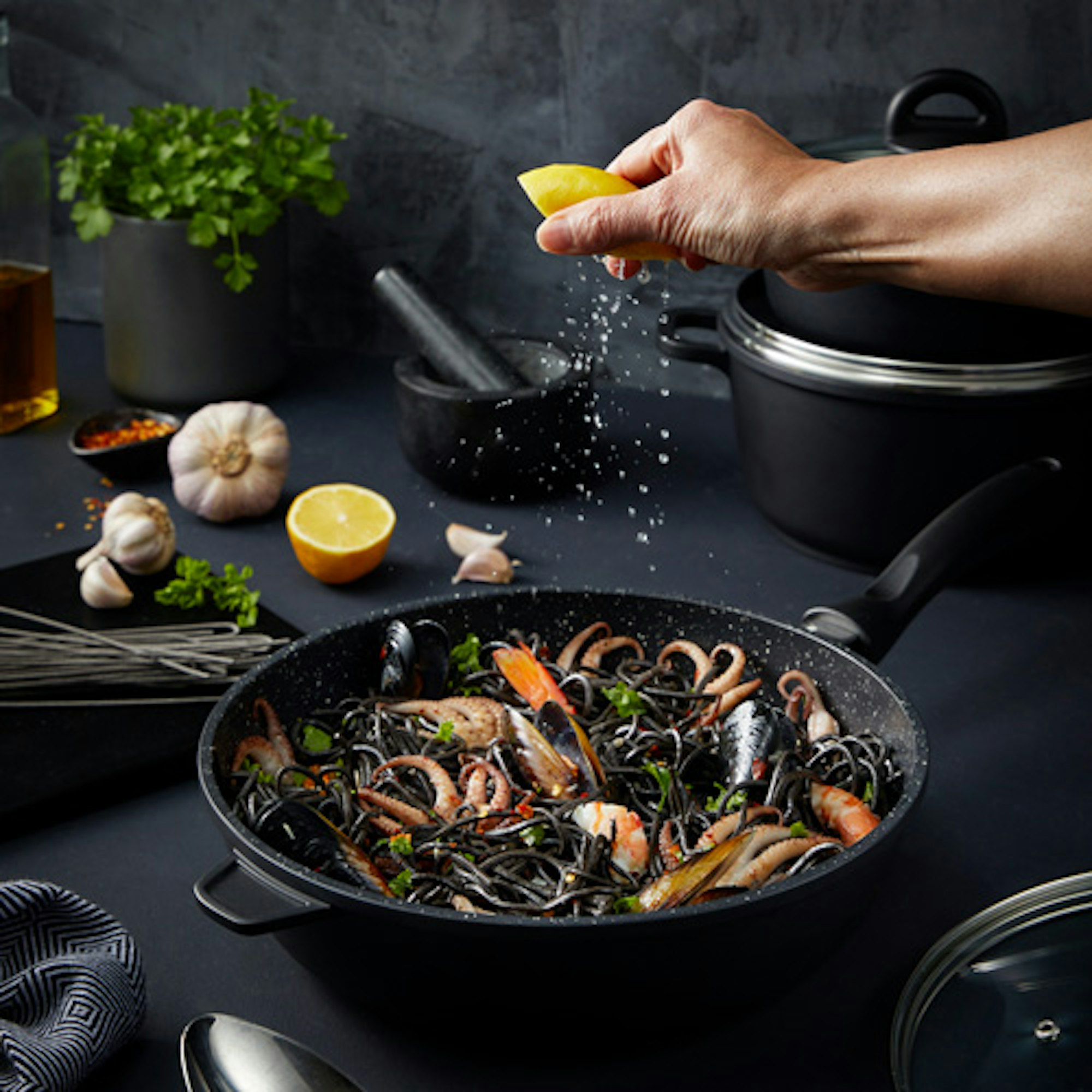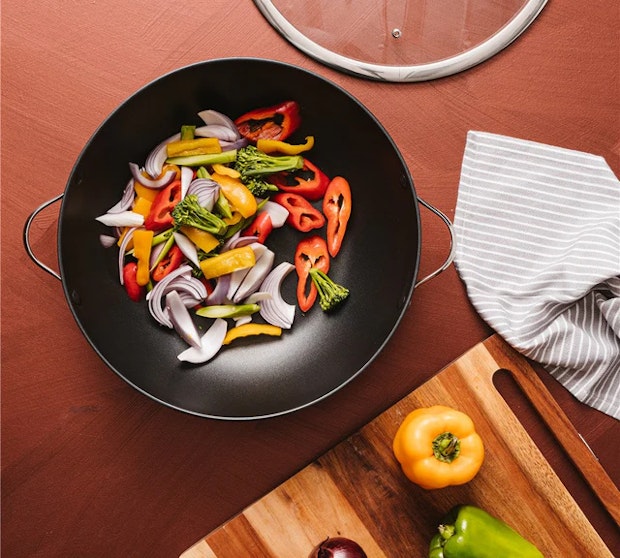How to Properly Cook Using a Wok

The wok, a versatile and traditional pan taking its roots in Asian cuisines, has become a staple in kitchens around the globe. Its unique shape and design make it an excellent tool for a variety of cooking methods. Mastering the use of a wok can bring a new level of flavour and texture to your dishes with its unparalleled versatility and efficiency, transforming simple ingredients into gastronomic delights.
What is a Wok?
A wok is an essential culinary tool, deeply rooted in the traditions of Asian cooking, particularly Chinese cuisine. Characterised by its distinctive deep, rounded bowl shape and versatile functionality, it is designed for a variety of cooking techniques, including stir-frying, steaming, pan-frying, deep-frying, poaching, boiling, braising, searing, smoking, and making soup. Traditionally made from cast iron or carbon steel, modern adaptations include stainless steel and non-stick versions, catering to the needs of contemporary kitchens while aiming to replicate the high heat retention and even heat distribution of their traditional counterparts.
The wok's unique shape allows for quick cooking at high temperatures, essential for achieving the coveted 'wok hei' or 'breath of the wok'—a complex charred flavour that is the hallmark of authentic stir-fry dishes.
When to Use a Wok?
Understanding when and how to utilise a wok can elevate your cooking. It can be used for several cooking methods to create a variety of dishes.
1. Stir Frys
The wok's superior design is ideally suited for the high-heat and fast-paced cooking that stir-frying demands. Its unique, deep, and curved shape allows for efficient heat distribution, ensuring that ingredients cook evenly and rapidly, while its high sides make it easy to toss and turn ingredients without spilling. This is crucial for achieving the 'wok hei' or the breath of the wok, a complex charred flavour that is the hallmark of expert stir-frying.
2. Browning Meat
When browning meat, ensuring that every piece of meat achieves a perfect sear without overcrowding is crucial. The unique shape of the wok, with its wide opening and deep, sloping sides allows for high heat to be concentrated at the bottom while providing ample space to push already seared pieces up the sides.
This achieves that perfect sear without steaming the meat, a common pitfall when overcrowding a flat pan. The wok's design facilitates rapid, even heating and the ability to toss and turn the meat efficiently, making sure that each piece is beautifully browned and flavoured.
The key to maximising the wok's potential for browning meat lies in the preheating process and the use of the right type of oil - one with a high smoke point, such as peanut or canola, to withstand the high temperatures without burning. This not only enhances the flavour but also contributes to a desirable texture, creating a succulent inside with a crispy, caramelised exterior.
3. Deep Frying
The broad opening and deep basin of a wok allow for efficient heat distribution. This helps in achieving that impeccably crispy texture we all crave in deep-fried foods. Unlike traditional deep fryers, the wok's sloped sides make it easier to manage and maneuver food items while minimising oil splatters.
This is particularly useful when frying delicate items that need to be moved or turned frequently to ensure even cooking. The wok's design requires less oil than a standard pot or fryer, making it a healthier option and a more economical choice.
How to Use a Wok When Cooking

1. What Oil to Use
The hallmark of wok cooking is its intense heat, which demands oils that not only have high smoke points to resist burning but also possess the ability to imbue dishes with a perfect sear, enhancing their texture without leaving a bitter, burnt aftertaste. Equally critical is choosing oils with a neutral flavour profile.
Our aim in the kitchen is to elevate and harmonise the natural tastes of the ingredients, not to overshadow them with the oil's own flavour. The right oils act as silent partners, maintaining the integrity and purity of the ingredients' flavours. Among the many options available, these are a few select oils that meet these stringent criteria.
- Peanut
- Vegetable or Canola
- Avocado
- Grapeseed
2. What Heat to Cook On
When cooking with a wok, the key to achieving that quintessential sear and flavour, often referred to as "wok hei" in Chinese cuisine, is to use high heat. The design of the wok, with its curved sides, is specifically intended for the food to be cooked quickly on high heat, allowing for ingredients to be seared and cooked through rapidly while retaining their texture and nutrients.
This high-heat method is crucial for stir-fries, where ingredients need to be cooked at a blistering pace to achieve the perfect balance of tenderness and crunch. It's this ability to achieve a harmonious balance of flavours, textures, and aromas in a matter of minutes that calls for high heat in wok cooking.
3. What Burner or Element to Use
The choice of burner or element is crucial to achieve the high heat necessary for authentic stir-frying and other wok cooking methods. Gas burners provide the intense and easily adjustable heat that is essential for the quick cooking techniques typically used with a wok.
Ideally, a burner specifically designed for wok cooking, with a concave shape, will cradle the wok and focus the heat more efficiently, allowing for the high temperatures needed to properly sear ingredients. If using an electric stove, an electric wok with its own heating element can be a suitable alternative, though it may not always replicate the intensity of a gas flame.
4. What Order to Cook Food
To ensure everything cooks perfectly, it is important to understand the correct order to introduce ingredients to achieve the perfect balance of flavours and textures.
- Start with the protein, allowing it to sear and brown.
- Next, add spices to release their flavours.
- Follow with vegetables, adding those that take longer to cook first.
- Finally, incorporate your sauce, allowing it to thicken and coat the ingredients evenly.
5. What Utensils to Use
The traditional and most effective tools for wok are a long-handled chuan (spatula) and a hoak (ladle). The chuan, with its slightly curved edge, is perfectly designed for the high walls of the wok, allowing you to stir, flip, and move ingredients with ease, ensuring even cooking and preventing food from sticking or burning.
The hoak, on the other hand, is essential for soups, sauces, and deep-frying, enabling precise control over liquid ingredients. Both these utensils typically have long handles, which help in keeping your hands away from the high heat of wok cooking.
It's crucial that these tools are made from materials that can withstand high temperatures without melting or warping, such as stainless steel or wood. Using the right utensils enhances your control over the cooking process.
Cooking with a wok is an art that combines high heat, timing, and the right ingredients to create dishes that are full of flavour and texture. The wok offers versatility, efficiency, and the unique ability to impart a smoky, seared flavour that is impossible to achieve with any other cookware.
You will appreciate the wok both for its functionality and adaptability across a myriad of cooking techniques. Embracing the wok means embracing a tradition of cooking that is both ancient and remarkably relevant in today's culinary landscape. Discover the collection of woks from Baccarat online to enhance your culinary exploration in the kitchen now.
Cooking With a Wok FAQs
Why not to use olive oil?
Olive oil has a lower smoke point compared to the oils recommended above. Using it in a wok can lead to burning and an unpleasant taste. Stick to high smoke point oils to achieve the best results.
How to season a wok?
a) Seasoning a wok begins with a thorough washing using hot soapy water and a scrubbing pad.
b) After drying, preferably over low heat on the stove to evaporate any remaining moisture, coat the interior surface lightly with a high smoke point oil, such as peanut, canola, or grapeseed oil.
c) Using a paper towel or a cloth, spread the oil evenly, ensuring the entire surface, including the sides, is coated.
d) Then, heat the wok over medium-high heat until it starts to smoke, rotating it to ensure the heat is evenly distributed and the oil coats the surface thoroughly. This process polymerizes the oil, creating a protective layer.
e) Allow the wok to cool, then repeat the oiling and heating process 2-3 times until the wok develops a dark, semi-glossy patina, indicating a well-seasoned wok ready for cooking.
How to clean a wok?
To clean a wok, especially one made of carbon steel or cast iron to maintain its seasoning and non-stick properties, you should start by rinsing it with hot water as soon as it's cool enough to handle. Use a bamboo brush or a soft sponge to gently scrub away any food particles, avoiding soap or metal scouring pads that can strip the seasoning.
For stubborn bits, simmer a little water in the wok for a few minutes, then scrape gently with a wooden spatula. Finally, apply a thin layer of cooking oil, wiping it around the entire surface with a paper towel, to protect the metal from rust and to maintain its seasoning.
Can you use a wok on an induction cooktop?
Yes, you can use a wok on an induction cooktop, but it requires a specific type of wok designed for induction cooking. A flat-bottomed wok made of a ferromagnetic material, such as cast iron or magnetic stainless steel, is recommended. Traditional round-bottomed woks are not suitable for induction cooktops unless you use an induction interface disk to create a compatible surface.
Which types of wok are the best to use?
Woks can come in a range of different materials, all offering a good cooking experience depending on your cooking expertise and dish type.
A hard anodised non-stick wok works well for most cooking. The hard anodising process transforms the surface of the aluminium wok into an extremely durable, corrosion-resistant finish that can withstand high heat without warping or deteriorating, making it perfect for the high-heat cooking methods often employed in wok cooking.
This process also creates a non-stick surface that is much more robust than traditional non-stick coatings, allowing for healthier cooking with minimal oil and easy cleanup.
Back to blog


